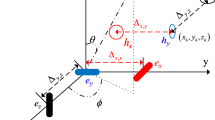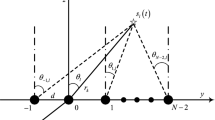Abstract
The topic of direction-of-arrival (DOA) estimation has attracted extensive attention in wireless communications, radars, sonars, etc. Compared to the traditional scalar sensor, electromagnetic vector sensor (EMVS) is attractive since it provides two-dimensional (2D) DOA estimation and additional polarization information of the incoming signals. However, existing algorithms are only suitable for Gaussian white noise scenario. In this paper, we investigate into DOA estimation using EMVS array with spatially colored noise, and a parallel factor (PARAFAC) estimator is proposed. Unlike the conventional direct PARAFAC algorithm, the covariance tensor-based PARAFAC model is considered. For fast PARAFAC decomposition purpose, the fourth-order covariance PARAFAC tensor is rearranged into a third-order PARAFAC tensor, so that the existing COMFAC algorithm is available and thus the factor matrices are estimated. Thereafter, the elevation angle estimation is accomplished via least squares (LS) technique, and the azimuth angles are estimated via vector cross-product. Besides, the polarization status of the source signal can be estimated via LS approach, which may be helpful to identify weak signals. Our estimator is flexible since it can be easily extended to nonuniform array and spatially colored noise scenario. Moreover, it offers better estimation performance than the traditional PARAFAC algorithm in the presence of colored noise. Detailed analyses concerning identifiability, complexity as well as Cramér–Rao bound (CRB) are provided. To show the effectiveness of the proposed estimator, numerical simulations have been designed.








Similar content being viewed by others
Data Availability Statement
My manuscript has no associated data.
References
H. Abeida, J. Delmas, Gaussian cramer-rao bound for direction estimation of noncircular signals in unknown noise fields. IEEE Trans. Signal Process. 53(12), 4610–4618 (2005). https://doi.org/10.1109/TSP.2005.859226
T. Ahmed, Z. Xiaofei, Z. Wang, DOA estimation for coprime EMVS arrays via minimum distance criterion based on PARAFAC analysis. IET Radar Sonar Nav. 13(1), 65–73 (2019). https://doi.org/10.1049/iet-rsn.2018.5155
I. Bekkerman, J. Tabrikian, Target detection and localization using MIMO radars and sonars. IEEE Trans. Signal Process. 54(10), 3873–3883 (2006). https://doi.org/10.1109/TSP.2006.879267
Bro. R, Sidiropoulos. N, Giannakis. G (1999) A fast least squares algorithm for separating trilinear mixtures. In: Proc. Int. Workshop on Independ. Compon. Anal. Blind Signal Separation (ICA 99), pp. 289–294. Aussois, France
C.E. Chen, F. Lorenzelli, R.E. Hudson, K. Yao, Stochastic maximum-likelihood DOA estimation in the presence of unknown nonuniform noise. IEEE Trans. Signal Process. 56(7), 3038–3044 (2008). https://doi.org/10.1109/TSP.2008.917364
H. Chen, C. Hou, Q. Wang, L. Huang, W. Yan, Cumulants-based toeplitz matrices reconstruction method for 2-D coherent DOA estimation. IEEE Sens. J. 14(8), 2824–2832 (2014). https://doi.org/10.1109/JSEN.2014.2316798
Q. Cheng, Y. Hua, Further study of the pencil-MUSIC algorithm. IEEE Trans. Aero. Elec. Sys. 32(1), 284–299 (1996). https://doi.org/10.1109/7.481269
S. Chintagunta, P. Palanisamy, 2D-DOD and 2D-DOA estimation using the electromagnetic vector sensors. Signal Process. 147, 163–172 (2018). https://doi.org/10.1016/j.sigpro.2018.01.025
Fernandez del Rio. JE, Catedra-Perez. (1997) MF The matrix pencil method for two-dimensional direction of arrival estimation employing an L-shaped array. IEEE Trans. Antenna. Propag. 45(11), 1693–1694. https://doi.org/10.1109/8.650082
R. Goossens, H. Rogier, A hybrid UCA-RARE/Root-MUSIC approach for 2-D direction of arrival estimation in uniform circular arrays in the presence of mutual coupling. IEEE Trans. Antenna. Propag. 55(3), 841–849 (2007). https://doi.org/10.1109/TAP.2007.891848
M. Haardt, F. Roemer, G. Del Galdo, Higher-order SVD-based subspace estimation to improve the parameter estimation accuracy in multidimensional harmonic retrieval problems. IEEE Trans. Signal Process. 56(7), 3198–3213 (2008). https://doi.org/10.1109/TSP.2008.917929
K. Han, A. Nehorai, Nested vector-sensor array processing via tensor modeling. IEEE Trans. Signal Process. 62(10), 2542–2553 (2014). https://doi.org/10.1109/TSP.2014.2314437
J. He, L. Li, T. Shu (2021) Direction finding of mixed fully and partially polarized sources using linear cold arrays. Signal Process. 178. https://doi.org/10.1016/j.sigpro.2020.107815
J. He, L. Li, T. Shu (2021) Sparse nested arrays with spatially spread orthogonal dipoles: High accuracy passive direction finding with less mutual coupling. IEEE Trans. Aero. Elec. Sys https://doi.org/10.1109/TAES.2021.3054056
J. He, Z. Liu, Computationally efficient 2D direction finding and polarization estimation with arbitrarily spaced electromagnetic vector sensors at unknown locations using the propagator method. Digital Signal Proc. 19(3), 491–503 (2009). https://doi.org/10.1016/j.dsp.2008.01.002
J. He, Z. Zhang, C. Gu, T. Shu, W. Yu, Cumulant-based 2-d direction estimation using an acoustic vector sensor array. IEEE Trans. Aero. Elec. Sys. 56(2), 956–971 (2020). https://doi.org/10.1109/TAES.2019.2921194
H. Huang, J. Yang, Y. Song, H. Huang, G. Gui, Deep learning for super-resolution channel estimation and DOA estimation based massive MIMO system. IEEE Trans. Veh. Tech. 67(9), 8549–8560 (2018)
J. Li, Direction and polarization estimation using arrays with small loops and short dipoles. IEEE Trans. Antennas Propag. 41(3), 379–387 (1993). https://doi.org/10.1109/8.233120
B. Liao, Fast angle estimation for MIMO radar with nonorthogonal waveforms. IEEE Trans. Aero. Elec. Sys. 54(4), 2091–2096 (2018). https://doi.org/10.1109/TAES.2018.2847958
T. Liu, F. Wen, L. Zhang, K. Wang (2019) Off-grid doa estimation for colocated MIMO radar via reduced-complexity sparse Bayesian learning. IEEE Access 7 . https://doi.org/10.1109/ACCESS.2019.293053
S. Miron, N. Le Bihan, J. Mars, (2005) Vector-sensor MUSIC for polarized seismic sources localization. EURASIP J. Adv. Signal Process. 48(8). https://doi.org/10.1155/ASP.2005.74
A. Nehorai, E. Paldi, Vector-sensor array processing for electromagnetic source localization. IEEE Trans. Signal Process. 42(2), 376–398 (1994). https://doi.org/10.1109/78.275610
W. Rao, D. Li, J.Q. Zhang, A tensor-based approach to L-shaped arrays processing with enhanced degrees of freedom. IEEE Signal Process. Lett. 25(2), 234–238 (2018). https://doi.org/10.1109/lsp.2017.2783370
R. Roy, T. Kailath, ESPRIT-estimation of signal parameters via rotational invariance techniques. IEEE Trans. Acoust. Speech Signal Process. 37(7), 984–995 (1989). https://doi.org/10.1109/29.32276
J. Shi, F. Wen, T. Liu, Nested MIMO radar: coarrays, tensor modeling and angle estimation. IEEE Trans. Aero. Elec. Sys. 57(1), 573–585 (2021). https://doi.org/10.1109/TAES.2020.3034012
N.D. Sidiropoulos, L. De Lathauwer, X. Fu, K. Huang, E.E. Papalexakis, C. Faloutsos, Tensor decomposition for signal processing and machine learning. IEEE Trans. Signal Process. 65(13), 3551–3582 (2017). https://doi.org/10.1109/TSP.2017.2690524
J. Steinwandt, F. Roemer, M. Haardt, G. Del Galdo, Deterministic cramer-rao bound for strictly non-circular sources and analytical analysis of the achievable gains. IEEE Trans. Signal Process. 64(17), 4417–4431 (2016). https://doi.org/10.1109/TSP.2016.2566603
P. Stoica, A. Nehorai, Performance study of conditional and unconditional direction-of-arrival estimation. IEEE Trans. Acous. Speech Signal Process. 38(10), 1783–1795 (1990). https://doi.org/10.1109/29.60109
X. Wang, M. Huang, L. Wan (2020) Joint 2D-DOD and 2D-DOA estimation for coprime EMVS-MIMO radar. Circ. Syst. Signal Process. https://doi.org/10.1007/s00034-020-01605-5
Y. Wang, W. Wu, X. Zhang, W. Zheng, Transformed nested array designed for DOA estimation of non-circular signals: Reduced sum-difference co-array redundancy perspective. IEEE Commun. Lett. 24(6), 1262–1265 (2020). https://doi.org/10.1109/LCOMM.2020.2977293
F. Wen, J. Shi (2020) Fast direction finding for bistatic EMVS-MIMO radar without pairing. Signal Process. 173. https://doi.org/10.1016/j.sigpro.2020.107512
F. Wen, J. Shi, Z. Zhang, Joint 2D-DOD, 2D-DOA, and polarization angles estimation for bistatic EMVS-MIMO radar via PARAFAC analysis. IEEE Trans. Veh. Technol. 69(2), 1626–1638 (2020). https://doi.org/10.1109/TVT.2019.2957511
F. Wen, J. Shi, Z. Zhang (2021) Closed-form estimation algorithm for EMVS-MIMO radar with arbitrary sensor geometry. Signal Process. 186. https://doi.org/10.1016/j.sigpro.2021.108117
F. Wen, X. Xiong, J. Su, Z. Zhang, Angle estimation for bistatic MIMO radar in the presence of spatial colored noise. Signal Process. 134, 261–267 (2017). https://doi.org/10.1016/j.sigpro.2016.12.017
F. Wen, Z. Zhang, G. Zhang, Y. Zhang, X. Wang, X. Zhangc, A tensor-based covariance differencing method for direction estimation in bistatic MIMO radar with unknown spatial colored noise. IEEE Access 5, 18451–18458 (2017). https://doi.org/10.1109/ACCESS.2017.2749404
K.T. Wong, X. Yuan (2011)“vector cross-product direction-finding” with an electromagnetic vector-sensor of six orthogonally oriented but spatially noncollocating dipoles/loops. IEEE Trans. Signal Process. 59(1), 160–171. https://doi.org/10.1109/TSP.2010.2084085
K.T. Wong, M.D. Zoltowski, Uni-vector-sensor ESPRIT for multisource azimuth, elevation, and polarization estimation. IEEE Trans. Antennas Propag. 45(10), 1467–1474 (1997). https://doi.org/10.1109/8.633852
K.T. Wong, M.D. Zoltowski, Closed-form direction finding and polarization estimation with arbitrarily spaced electromagnetic vector-sensors at unknown locations. IEEE Trans. Antennas Propag. 48(5), 671–681 (2000). https://doi.org/10.1109/8.855485
K.T. Wong, M.D. Zoltowski, Self-initiating music-based direction finding and polarization estimation in spatio-polarizational beamspace. IEEE Trans. Antennas Propag. 48(8), 1235–1245 (2000). https://doi.org/10.1109/8.884492
X. Yang, Z. Zheng, B. Hu, Off-grid DOA estimation of incoherently distributed non-circular sources via generalised approximate message passing. Electron. Lett. 52(4), 262–264 (2016). https://doi.org/10.1049/el.2015.1973
Yilmazer. N, Jinhwan Koh, Sarkar. TK (2006) Utilization of a unitary transform for efficient computation in the matrix pencil method to find the direction of arrival. IEEE Trans. Antenna. Propag. 54(1), 175–181. https://doi.org/10.1109/TAP.2005.861567
N. Yuen, B. Friedlander, DOA estimation in multipath: an approach using fourth-order cumulants. IEEE Trans. Signal Processing 45(5), 1253–1263 (1997). https://doi.org/10.1109/78.575698
X. Zhang, Z. Xu, L. Xu, D. Xu, Trilinear decomposition-based transmit angle and receive angle estimation for multiple-input multiple-output radar. IET Radar Sonar Nav. 5(6), 626–631 (2011). https://doi.org/10.1049/iet-rsn.2010.0265
Z.D. Zheng, Y. ZJ, Fast method for multi-target localisation in bistatic MIMO radar. Electron. Lett. 47(2), 138–139 (2011). https://doi.org/10.1049/el.2010.2577
M.D. Zoltowski, M. Haardt, C.P. Mathews, Closed-form 2-D angle estimation with rectangular arrays in element space or beamspace via unitary ESPRIT. IEEE Trans. Signal Process. 44(2), 316–328 (1996). https://doi.org/10.1109/78.485927
M.D. Zoltowski, K.T. Wong, ESPRIT-based 2-D direction finding with a sparse uniform array of electromagnetic vector sensors. IEEE Trans. Signal Process. 48(8), 2195–2204 (2000). https://doi.org/10.1109/78.852000
Author information
Authors and Affiliations
Corresponding author
Additional information
Publisher's Note
Springer Nature remains neutral with regard to jurisdictional claims in published maps and institutional affiliations.
Rights and permissions
About this article
Cite this article
Wang, C., Ai, L., Wen, F. et al. An Improved PARAFAC Estimator for 2D-DOA Estimation Using EMVS Array. Circuits Syst Signal Process 41, 147–165 (2022). https://doi.org/10.1007/s00034-021-01748-z
Received:
Revised:
Accepted:
Published:
Issue Date:
DOI: https://doi.org/10.1007/s00034-021-01748-z




